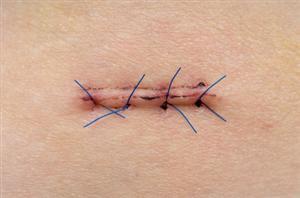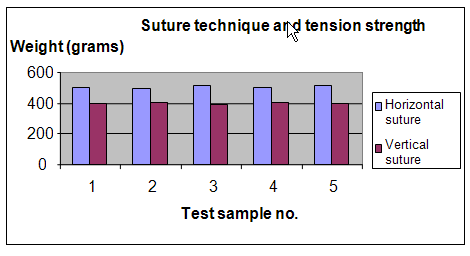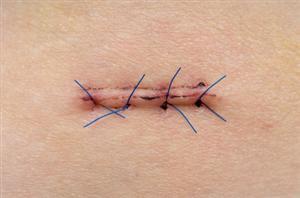| Complexity level: | 9 |
| Project cost ($): | 40 |
| Time required: | 1 hour to prepare, 1 hour for the science project experiment |
| Material availability: | Easily found. May be purchased at a supermarket. |
| Safety concerns: | Handle knives and needles very carefully. Adult assistance is required. |
Hypothesis
Horizontal mattress sutures are able to withstand a higher tension than vertical mattress sutures.
Overview
Mattress sutures
Mattress sutures are techniques used to close an open wound using stitches. The purpose of using mattress sutures is to help close the wound, support the wound until it heals, minimize the bleeding and help prevent infection. The common techniques used for mattress sutures are horizontal, vertical and corner stitch methods.
Vertical mattress sutures are mainly used to avert skin edges. This technique helps to minimize the tension across an open wound and reduces dead space. It will normally have to be removed after 5 to 7 days in order to minimize the risk of scarring. The vertical stitch is normally applied to wounds located at the neck or concave skin surface where the edges of the wound will have a tendency to become inverted.
Horizontal mattress suture will help to distribute the tension along the edge of the wound. This method is used to pull the edges of the wound across a distance and hold them together. They will have a high risk of scarring if not removed after 7 days. The technique is used to hold the flaps of the skin in place and also for holding fragile skin together.
Scientific Terms
Materials
The materials required for this science project:
- 10 pieces of chicken breast, with skin
- 1 chopping board
- 1 carving knife
- 4 large fishing hooks
- 10 weights 100 grams each
- 10 weights 10 grams each
- A towel hanger
- 2 pieces of string
- A mattress suture
- A suture needle
Procedure
1. For this experiment, the independent variable is the type of mattress suture technique used – horizontal and vertical methods. The dependent variable is the amount of tension the stitches can withstand. This is determined by applying weights to increase the tension until the stitches give way. The constants (control variables) are the size and type of meat used, the number of stitches, the distance between the stitches and the type of fish hooks used.
2. Ten pieces of chicken breast are sliced to 10 mm thickness each. In this experiment, the side with the skin will be used for testing.
3. A 5-centimeter long cut is made in the middle of the 10 chicken breasts. Five pieces of the chicken breast will be stitched using the horizontal mattress suture technique and the remaining 5 will the stitched using the vertical mattress suture technique. Four stitches are used in each piece of chicken.
4. The chicken breast is hung from the towel hanger using 2 fish hooks and a string. The stitches and the cut will be in a horizontal position. The other string and 2 fish hooks will be used to support the weights at the bottom of the chicken breast. The weighs will be added 10 grams at a time until the stitches give way. The final weight is recorded in the table given below.


Results
It was observed that the horizontal mattress suture was able to withstand about 500 grams of weight compared to the vertical mattress suture, which could withstand only 400 grams.
|
Mattress suture technique |
Tension strength of horizontal and vertical mattress sutures (grams) |
||||
|
1 |
2 |
3 |
4 |
5 |
|
|
Horizontal |
500 |
490 |
510 |
500 |
510 |
|
Vertical |
400 |
410 |
390 |
410 |
400 |
The graph below represents the results of our science project experiment:

Conclusion
The hypothesis that horizontal mattress sutures are able to withstand higher amount of tension than vertical mattress sutures, is proven to be true.
The use of proper mattress suturing techniques will help to minimize the amount of scarring on an open wound, after it has healed. There are several techniques, suture materials and needles for the surgeon to choose. The type of suture material and needle used will depend on the thickness of the skin, location of the wound and the amount of tension that needs to be applied on the wound.
Also consider
Try to repeat this science experiment using a different number of stitches.
The experiment can also be repeated using different techniques, like the corner stitch.
References
Mattress sutures: Vertical, Horizontal and corner stitch - http://www.aafp.org/afp/2002/1215/p2231.html
Suturing techniques - http://emedicine.medscape.com/article/1824895-overview

